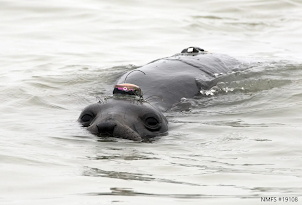by Samantha Dvorin, Archie Williams High School
 |
| Female elephant seal recording data (Costa, 2022) |
One marine animal is making a big splash in the scientific community for its assistance in tracking ocean temperature fluctuations using tagged sensors, population data, and migration patterns. The mysterious elephant seals were once some of the most hunted ocean creatures, almost to the point of extinction in the nineteenth century. Their thick layer of blubber was exploited by whalers and hunters and used as an oil source. These animals have made a huge comeback thanks to conservation efforts, awareness, and legal protection, especially in Antarctica and California.
There are two species of these earless marine mammals, the Northern elephant seal (Mirounga angustirostris) and the Southern elephant seal (Mirounga leonina). The Northern elephant seal is native to California, Baja California, Mexico, and other nearby offshore islands while the Southern elephant seal can be found in sub-Antarctic and Antarctic waters (Moritsch & Lee, 2021). Most elephant seals spend their time breeding on land but living in colder water. Breeding season is an especially intense time for these animals as males fight for dominance and battle to collect a large group of female elephant seals. After the breeding season, they make their way to the water and spend their time migrating in search of food. They spend months at sea searching and diving deep for fish, squid, and similar marine creatures (U.S. National Park Service, 2021).
Despite defying the odds and repopulating, elephant seals are still left to face the consequences of climate change. As the burning of fossil fuels like coal, oil, and gas continues, marine animals are some of the most affected because they rely on the oceans for their habitat and food. Sea ice provides both a home for aquatic creatures like polar bears, penguins, and seals, but it also affects the temperature of the oceans. Many organisms are being forced to migrate due to warming water; some even have to change their feeding and breeding patterns to acclimate to their new normal. These prolonged water warming events are becoming more common and are referred to as Marine heat waves. The most prolific in recent history is the North Pacific Blob which stretched from 2013 until 2016. It was the longest-lasting and most extensive marine heat wave recorded which caused many elephant seals to migrate toward colder water where they can find better prey. But scientists are using elephant seals to inform the world of the extent of damage done by these heat waves both on the surface and deeper (Wong, 2022).
| Southern elephant seals with sensors (McMahon, 2016) |
| Northern Elephant Seals at Año Nuevo Reserve (Hosler, 2022) |
On September 21, 2022, Ph.D. student Alison Payne presented “Cutting Edge Research on Elephant Seals at Año Nuevo Reserve” at the Marin Science Seminar where she discussed the natural history of elephant seals and the long-term monitoring program at Año Nuevo. Learn more about Alison and her work here.
Works Cited
Herraiz, L. (2016, August 23). Seals help scientists get to the bottom of Antarctic changes. Carbon Brief. Retrieved December, 2022, from https://www.carbonbrief.org/seals-help-scientists-get-to-the-bottom-of-antarctic-changes/
Hosler, R. R., Keates, T. R., Costa, D. P., & Edward, C. A. (2022, July 4). Extent and Magnitude of Subsurface Anomalies During the Northeast Pacific Blob as Measured by Animal-Borne Sensors. AGU Online Library. Retrieved December, 2022, from https://agupubs.onlinelibrary.wiley.com/doi/full/10.1029/2021JC018356
Moritsch, M., & Lee, C. J. (2021). Elephant Seals. National Geographic. Retrieved December, 2022, from https://www.nationalgeographic.com/animals/mammals/facts/elephant-seals
U.S. National Park Service. (2021, May 21). Northern Elephant Seal. National Park Service. Retrieved December, 2022, from https://www.nps.gov/places/northern-elephant-seal.htm
Wong, K. (2022, August 4). Elephant Seals Measure "the Blob" - Natural Reserve System. UC Natural Reserve System. Retrieved December, 2022, from https://ucnrs.org/elephant-seals-measure-the-blob/
Yale Environment 360. (2016, August 24). How Elephant Seals Are Helping Scientists Study Climate Change. Yale E360. Retrieved December, 2022, from https://e360.yale.edu/digest/how_elephant_seals_are_helping_scientists_study_climate_change



